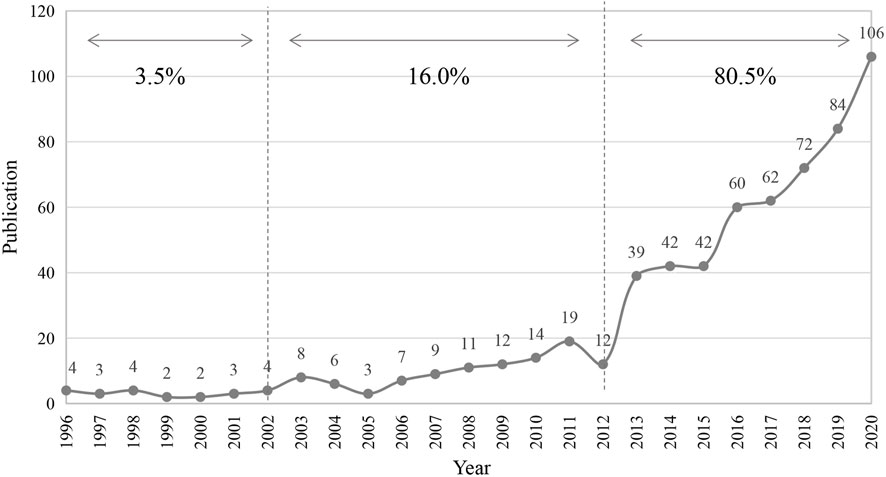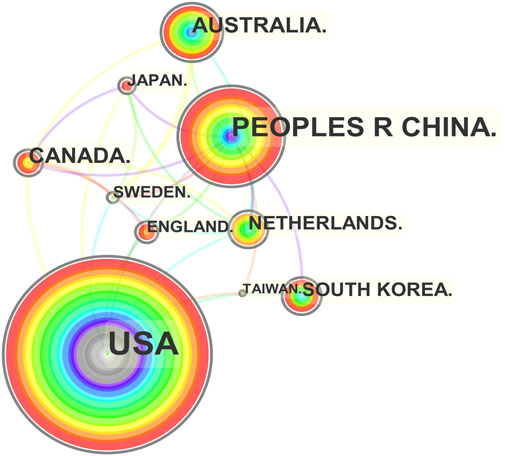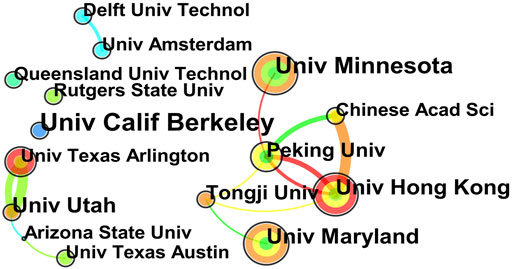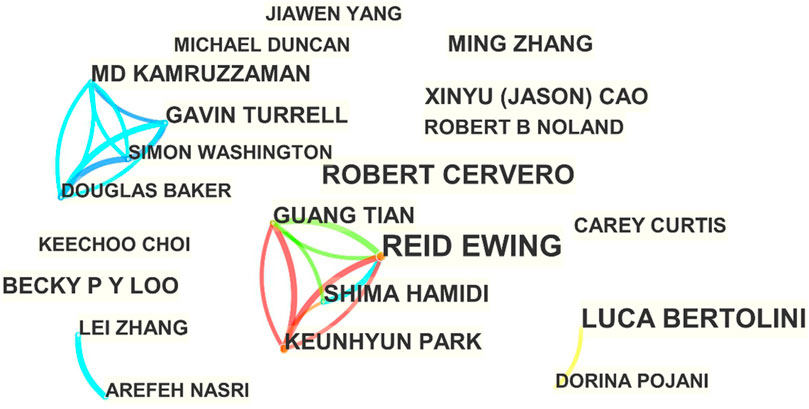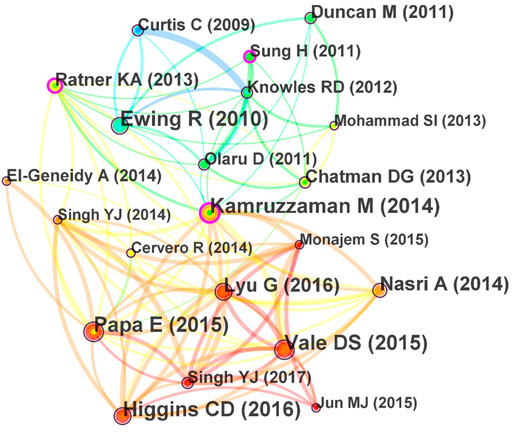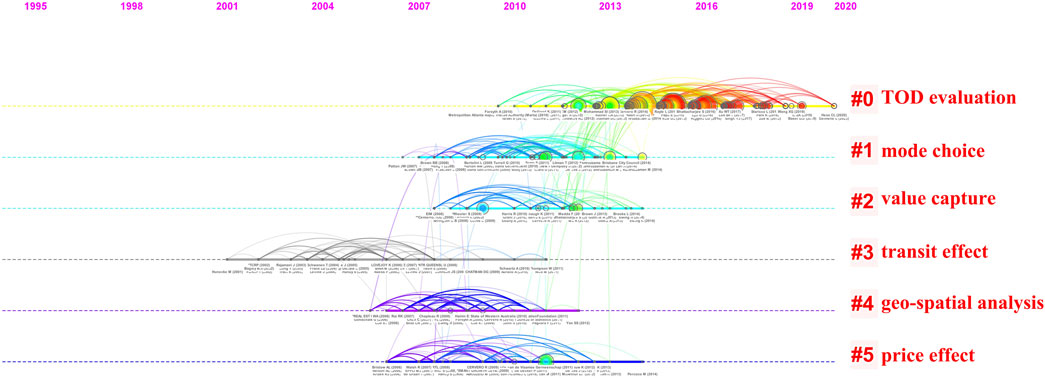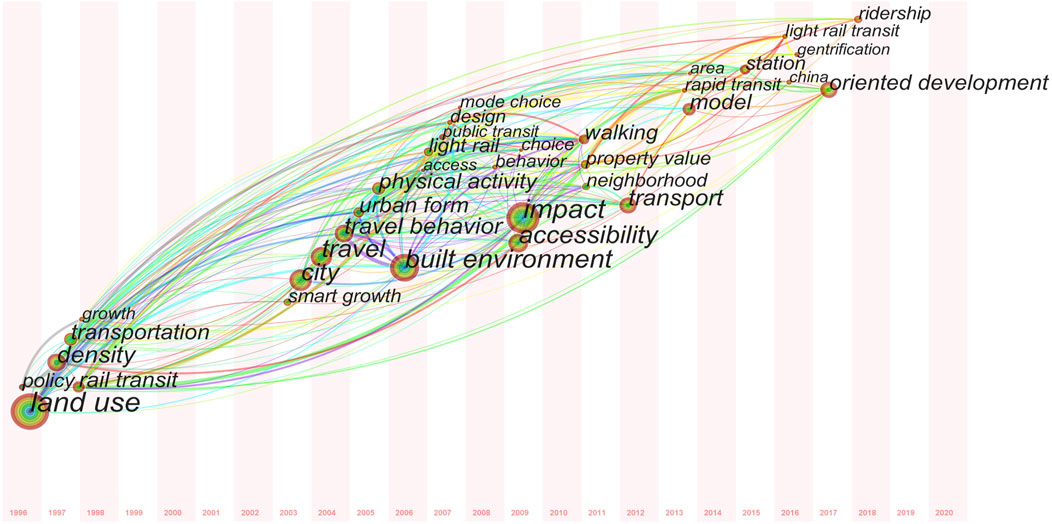International research progress and trend of transit-oriented development: An analysis of knowledge mapping based on cite space
- School of Urban Construction, Wuhan University of Science and Technology, Wuhan, China
Transit-oriented development (TOD) which is regarded as one of the most successful planning methods for urban and transport sustainability, has garnered much attention from academics and planners. Despite the growing interest in TOD research, there has not been a comprehensive review of the knowledge structure, research hotspots and emerging trends about TOD research. This study aims to address the research gap by providing a bibliometric overview and visualization of the TOD research. Based on the bibliometric analysis methods, this study uses data collected from Web of Science (WOS) and uses CiteSpace software for visualizing and analyzing international research progress and trends in the TOD field. The results showed that publications on TOD research increased significantly, and most of the articles were published by the United States and China. Universities were the mainstays of the TOD research institutions, and the most productive authors were Dr. Ewing, Dr. Cervero, and Dr. Bertolini. The co-citation network analysis showed that the influential articles were published by Kamruzzaman, Vale, and Papa, and six main research area could be detected. The keyword co-occurrence network analysis displayed three stages for the evolution of TOD research, and popular topics in different stages were revealed. Three Frontier hotspots were identified by the keywords burst analysis, namely oriented development, pattern, and typology.
1 Introduction
Rapid urbanization and population growth worldwide have led to many urban problems, such as air pollution, traffic congestion and suburban sprawl (Pezeshknejad et al., 2020; Dou et al., 2021). TOD is an effective sustainable planning strategy that provides comprehensive solutions to the aforementioned car-based problems (Li et al., 2019). By clustering urban developments around transit stations, TOD creates dense, mixed-use, and pedestrian-friendly neighborhoods (Cervero and Landis, 1997). The common goal of TOD is to achieve the integration of land use and transportation (Li et al., 2019).
Peter Calthorpe (1993), an American urban planner, first proposed the concept of TOD and defined it as “mixed-use communities within 10 min walking distance along the regional transit systems”. Since then, TOD planning has begun to surge worldwide (Singh et al., 2017; Su et al., 2021). There also have been an increase in journal articles in the TOD field since TOD projects have proliferated around the world. To date, some scholars have offered reviews of TOD research. Ibraeva et al. (2020) reviewed the achievements and challenges in the TOD field, such as the TOD concept, TOD effect and TOD planning. The research published by Knowles et al. (2020) traced the past, current, and future development of TOD. However, they adopt the traditional literature review method and emphasize the development venation of TOD. It is difficult to grasp the research progress and the Frontier dynamics of TOD in more detail. Thus, it is essential to provide a synthetic and systematic review of the literature on the TOD field.
Recently, the use of bibliometric analysis methods to quantify specific research fields or journals has become more common (Feng et al., 2022). Compared with traditional literature review methods, the bibliometric analysis method is an effective way to identify spatio-temporal distribution, knowledge structure, and evolution law of literature (Yu et al., 2020; Kou et al., 2021). For bibliometric analysis methods, CiteSpace software provides a visual citation analysis tool, which can help effectively describe the knowledge structure, research hotspots and emerging trends of various literature in a research field (Feng et al., 2022). Using the bibliometric analysis methods, our previous works revealed some statistical trends of TOD, but the meaning of the trends was missing (Tao et al., 2021). This study makes an effort to fill this gap and provides a comprehensive foundation and deep understanding of the evolution of TOD research. Based on the data extracted from WOS and CiteSpace software, trends and hotspots in the TOD field are visualized and analyzed. The primary objectives of this research are to 1) summarize the pattern of TOD publications, 2) identify the significant contributors to TOD research, and 3) discover trending research topics.
2 Data sources and methods
2.1 Data sources
The scientific publications for this bibliometrics analysis were extracted from the WOS database. As a commonly accepted database, the WOS includes necessary information for bibliometrics analysis. To ensure high data quality, three classic index types in the WOS were selected, including SCIE, SSCI, and A&HCI. The search formula was: Topic search = Transit Oriented Development. The publication language was set to “English”. Only the “Article” document type was selected, while excluding book reviews, meetings, editorials, and books which are not the focus in this study. The search was conducted on 20 January 2021, and 702 documents were initially obtained. Following the manual review of titles and abstracts, we removed the irrelevant and duplicate documents so that the selected literature reflected its typicality and relevance. Finally, a total of 630 articles with a time span of 1996–2020 are retained as the basic data for analysis.
2.2 Analytical methods
Bibliometric analysis is a robust measurement method for quantitative statistical analysis of scientific productions (Du et al., 2021). Compared with traditional literature review methods, the bibliometric analysis method has more advantages in better understanding the evolution of research, such as large capacity, multi-dimensional analysis, visualization and objectivity (Feng et al., 2022). A variety of software tools have been available for bibliometric analysis, such as SciMAT (Yu and Hong, 2022), BibExcel (Persson et al., 2009), VOSviewer (Eck and Waltman, 2010) and CiteSpace (Chen, 2006). Based on a comparison of these procedures, we revealed that they performed similar functions, such as co-citation and co-occurrence. But CiteSpace can draw timeline graphs and citation burst maps which would make it more effective to demonstrate the dynamics of a research field. Therefore, we chose CiteSpace software to systematically perform the bibliometric analysis of the selected documents and drew visual maps. CiteSpace software, developed by Dr. Chaomei Chen, has been widely used in bibliometric analysis (Chen, 2006). There are four sets of analyses in this study. First, the publication trend of the TOD research was presented through bibliometrics analyses. Second, the cooperation network analysis of countries, institutions, and authors was performed to determine where the most contributions came from. Third, the co-citation and cluster analysis were conducted to identify the most important citations and develop a knowledge base. Finally, cutting-edge knowledge and research trends about TOD were identified by the co-occurrence and burst analysis of keywords.
3 Results
3.1 Publication trend
As shown in Figure 1, the amount of annual publications related to TOD research shows an obvious upward trend, with four papers in 1996 rising to 106 papers in 2020. According to the number of publications, the research trend could be divided into three stages.
The first stage lasted about 7 years from 1996 to 2002, with few articles published on TOD topics. During this period, no more than four articles published in any of these years, resulting in a 3.5% share of the total number of publications. Despite the lack of rich research, it was at this phase that the concept of TOD was universally accepted, laying the theoretical groundwork for subsequent research (Boarnet and Crane, 1998; Boarnet and Compin, 1999). Density, Diversity, and Design, the 3Ds identified by Cervero and Landis (1997) were the main characteristics of a TOD during this period.
In the second stage between 2003 and 2012, the number of published papers grew steadily and accounted for 16.0% of the total. The concept of TOD continuously matured in this stage. The dimensions that characterized TOD expanded from 3Ds to 5Ds, which included Destination accessibility and Distance to transit (Ewing and Cervero, 2010). During this stage, scholars and planners also conducted a series of case studies of TOD in cities worldwide (Gilat and Sussman, 2003; Shelton and Lo, 2003; Cervero and Day, 2008; Dill, 2008; Cervero and Murakami 2009).
The third stage showed the greatest increase, from 39 articles in 2013 to 106 articles in 2020. The number of papers that published in this period accounted for 80.5% and had not hit a peak, indicating that TOD had generally become a Frontier research field and that the number of articles would continue to increase. Ogra and Ndebele (2014) proposed the concept of 6Ds, which contained the six D-Demand management. Knowles and Ferbrache (2016) regarded high frequency transit services as the seventh feature for successful TODs. It is important to note that through 2 decades of development, there was a surge in the number of publications in 2013. Especially the United States, where TOD is mainly implemented, the maximum annual publications were nine before 2012, but the publications increased to 20 in 2013. Examples of successful TOD have led more cities to adopt TOD as a key planning policy and attracted more scholars to join the TOD research since then.
3.2 Cooperation networks
This section examines the cooperation networks of countries, institutions, and authors in order to better understand the major contributors who had a substantial impact in the field of TOD.
3.2.1 Country cooperation network
Based on the CiteSpace software, the country collaboration network is depicted in Figure 2. The figure only displays countries with more than 10 articles published on the topic. The United States (297 articles) and China (147 articles) clearly are the leading source country of research articles, followed by Australia (39 articles), Canada (34 articles), South Korea (29 articles) and Netherlands (29 articles). All these countries are developed countries, except for China. The United States and China also had the highest values of centrality, 0.48 and 0.35 respectively, and they cooperated closely. This reveals that the United States and China were two main research forces in the TOD field, and their academic research was closely combined with that of other countries.
The TOD principles were first adopted in US cities, and the first paper in the field of TOD research was also published by the United States in 1996 (Cervero 1996). Since then, there has been no interruption of publications, making it the country with the most publications. Later on, many European countries adopted TOD as their key planning approach in urban regeneration, such as Netherlands, England and Sweden. Then, Cities in Asia Pacific Region adopted TOD strategy only in the recent decades to distribute metropolitan growth along mass transit corridors (Kong and Pojani 2017). The concept of TOD was first introduced into China after 2000. After several years of silence, the study of TOD has became popular in China since 2010, and the number of publications increased sharply, making China the country with the fastest growth in publications. At present, China is in a stage of rapid growth in rail transit planning and construction (Li et al., 2020). Many local governments implement TOD as their primary development strategy to integrate transport and land use, while urban planners and policy makers promote the TOD model within a Chinese context. Although the number of publications by China (34 articles) is less than that of the United States (36 articles) in 2020, publications by China may exceed the United States in the near future according to the current trend.
3.2.2 Institution cooperation network
The TOD publications’ institution cooperation network is depicted in Figure 3. We set a threshold of 10 publications, and 15 institutions met the threshold. There were numerous TOD research institutions in the United States, such as the University of California Berkeley, University of Minnesota, University of Utah, University of Maryland, and Arizona State University. The University of California Berkeley come out on top with 27 articles, followed by the University of Minnesota (21 articles). Many research institutions in China have also published a large number of articles, such as the University of Hong Kong (19 articles), Tongji University (15 articles), Peking University (14 articles), and the Chinese Academy of Sciences (10 articles). However, the centrality ranking differs from the ranking of the number of publications. Tongji University (0.21) and Peking University (0.13) are the top two institutions in terms of centrality, highlighting the importance of these two Chinese institutions in TOD research.
3.2.3 Author cooperation network
Figure 4 depicts the TOD publications’ author cooperation network. Authors who published more than five articles within this network are shown in the figure. Among these prolific scholars, R. Ewing (16 articles) ranked first, followed by R. Cervero (12 articles), L. Bertolini (11 articles), and S. Hamidi (8 articles), which suggested that these authors were the most active authors on TOD research. One of the earliest researchers to pay attention to this field was Dr. Robert Cervero, who published his first paper in 1996 (Cevero, 1996). Zhang Pingyu from the Chinese Academy of Sciences, who published his paper in 2002, was the earliest Chinese researcher in this field (Zhang et al., 2002). Contrary to the close association shown by countries cooperative networks, the author cooperative network is more dispersed, just like a starry sky, and most authors did not cooperate with each other. Two small cooperative groups have been formed to study TOD. The first group was an American cooperative research group including R. Ewing and other three researchers. The other group was an Australian cooperation research group that included Kamruzzaman and other scholars from the Queensland University of Technology as the core.
3.3 Co-citation analysis
Identifying the articles being cited in the TOD field can be done with the aid of co-citation analysis. According to the bibliometric analysis of the data, 2,761 references were cited by the 630 articles we extracted, among which 21 articles were cited at least 15 times in the co-citation map (Figure 5). Based on co-citation analysis, the articles with the most co-citation were published by Kamruzzaman et al. (2014), Vale (2015), and Papa and Bertolini (2015), who received 39, 37, and 33 co-citations, respectively. Kamruzzaman et al. (2014) analyzed and classified the TODs of the entire Brisbane metropolitan area at the Census Collection District (CCD) level, which could enhance their planning, design, and decision-making. Vale (2015) used the node-place model to evaluate and categorize station areas in Lisbon at the local level. Using a 1-km2 grid, Papa and Bertolini (2015) measured the TOD degree of six metropolitan areas in Europe, expressing how urban development was concentrated along rail corridors and stations. TOD evaluation was the common theme of these papers.
To explore the knowledge evolution process of the TOD field, this study uses the CiteSpace for the visual timeline analysis of the co-citation clusters. Six primary groups that reflected the TOD research knowledge base were detected (Figure 6). “#0 TOD evaluation” formed the most important cluster and contained the most cited references, with a relatively long duration (2010–2020). The top three co-cited articles mentioned above are all belong to this cluster, so the topics about TOD evaluation were widely written. The node-place model was the most popular method for evaluating and classifying the performance of TODs, and it serves as the foundation for TOD typologies in a number of studies, with or without modification (Kamruzzaman et al., 2014; Papa and Bertolini 2015; Vale 2015; Lyu et al., 2016; Rodriguez and Kang 2020). Other researchers proposed different perspectives for TOD typology. Singh et al. (2014), for a instance, divided TOD into different types relied on the actual and potential TOD indexes. Using latent class analysis, Higgins and Kanaroglou (2016) constructed a TOD typology for Toronto.
“#3 transit effect” appeared earliest, with publications relating to the connection between transportation and travel behavior. Levine and Frank (2007) developed a stated-preference scale to analyze the transportation and land-use preference and actual neighborhood choices. Lund et al. (2006) explored how transit and station area investments affected transit ridership among those living and working in rail-based TODs.
Four clusters are formed around 2007, i.e., #1 mode choice, #2 value capture, #4 geo-spatial analysis, and #5 price effect. For cluster #1, scholars focused on the residents, such as residential dissonance, residential mobility, resident benefits, and new transit-oriented development residents. Olaru et al. (2011) evaluated how households considered TOD characteristics in their location decisions. Kamruzzaman et al. (2013) identified both the short-term mode choice behavior and the medium-term mode shift behavior of residential dissonance in TOD vs. non-TOD areas. Regarding cluster #2, Li et al. (2013) identified a value capture framework that tightened the connection between transit funding and TOD. Cluster #4, geo-spatial analysis, drew a large amount of interest from 2006 to 2012. Scholars analyzed the impacts of rail transport policy using geo-spatial data (Botte and Olaru 2012). For cluster #5, a hedonic price model was proposed to test the effect of TOD (Bartholomew and Ewing 2011; Duncan 2011).
3.4 Popular TOD research topics and trends
3.4.1 Keywords evolution analysis
Keywords can help to identify popular topics in different research periods. To clearly show the popular topics in different years and the connection and evolution among the research topics in the TOD field, we created a time zone perspective map of keywords. The keywords were used as the analysis node, and the diagram with the time zone method was acquired. Figure 7 shows how prevalent keywords vary over time. Similar to the annual number of publications trend, the theme evolution of TOD can also be divided into three phases: embryonic, prosperity, and new era (Tao et al., 2021).
In the embryonic stage from 1996 to 2002, “land use” was the most critical keyword, accompanying the emergence and evolution of TOD. “Density,” “rail transit,” “transportation,” “policy” and “growth” were the other keywords in TOD initial research. Although there were few hot keywords at this stage, they were all critical throughout the whole TOD research.
In the prosperity stage from 2003 to 2012, the research topics in the TOD field became more diverse. As TOD initiatives spread across the globe, there have been an unprecedented amount of core keywords since 2003. “Impact,” “built environment,” “travel behavior,” “city,” etc. were the keywords with a higher co-occurrence degree in this period. A lot of studies analyzed the effect of TOD, such as the effect on travel behavior (Gard, 2007; Park et al., 2018), real-estate prices (Duncan, 2011) and urban form (Ratner and Goetz 2013).
In the new era stage from 2013 to 2020, some new keywords have emerged, such as “oriented development,” “station,” “ridership,” “light rail transit,” “China” and “gentrification”. Deboosere et al. (2018) reframed TOD as accessibility-oriented development (AOD) to improve functional connections between transportation and neighborhoods. Vale et al. (2018) evaluated the integration of land use and transport at the local scale, so that TOD can be implemented at different levels: city, region and station. Some scholars emphasized that ridership reflected how people use the transit, and it should be studied as a critical indicator to evaluate TOD (Cao et al., 2020; Caset et al., 2020). While some cities invest in new light rail transit or bus rapid transit to promote urban regeneration, TOD also links new transport system and can be based on LRT or BRT (Cao and Porter-Nelson 2016; Lee and Sener 2017; Pezeshknejad et al., 2020). With the large number of TOD projects implemented in China, the amount of articles published by China had surged as mentioned before, and the case study of TOD with Chinese context had become the focus (Lyu et al., 2016; Li et al., 2019).
3.4.2 Keywords burst analysis
Keyword burst describes the significant change in the frequency of a keyword over a period of time, reflecting the research hotspots and emerging trends (Shi et al., 2022). With the help of CiteSpace’s burst feature, this study presents the top four keywords with the strongest citation burst in TOD research, as shown in Figure 8. The strength means the intensity of a sudden change, begin means the start year of the sudden change, and the red part means the duration of the sudden change. Among the four keywords, “oriented development” had the highest burst degree, followed by “pattern,” “growth management” and “typology”. Growth management once attracted much attention, and the duration of this hotspot was from 2005 to 2013. The emergence of oriented development, pattern and typology are in the new era stage, and they are not over yet. They would be the major frontiers of TOD research. Oriented development measured the degree of TOD supporting characteristics, and suggested the improvement to better TOD (Singh et al., 2017). Pattern examined how neighborhood characteristics influenced people’s propensity to travel by transit (Cao, 2015). Typology aimed to categorize TOD based on numerous station and surrounding region properties (Ibraeva et al., 2020).
4 Discussion and conclusion
TOD, which is regarded as one of the most successful planning methods toward urban and transport sustainability, has garnered much attention from academics and planners. Accordingly, numerous studies have been conducted in the TOD field over the past few decades. However, there has not been a comprehensive review of the knowledge structure, research hotspots and emerging trends on TOD research. Compared with traditional literature review methods, the bibliometric analysis method has more advantages in better understanding the evolution of research. Therefore, this study analyzed the publications from the beginning of the TOD research to the present with the assistance of the CiteSpace software, displaying the leading research countries, institutions and authors, theme evolution and research frontiers. 630 publications retrieved from the WOS database with a time span of 1996–2020 were used for bibliometric analysis.
In terms of the distribution of articles by publication year, there has been an obvious upward trend, with four papers published in 1996 and 106 articles published in 2020, especially in the past decade. With the emergence of TOD projects worldwide, discussion on implementation of TOD strategy has attracted much attention, and the number of publications has surged since 2013. Especially in the United States, where TOD strategy is mainly implemented, the number of publications doubled to 20 in 2013.
In terms of cooperation network analysis, the major resources for the TOD research were from the United States and China. The TOD principles were first adopted in US cities to re-centering urban development around transit stations (Cervero and Landis, 1997). The concept of TOD has received increased attention and investigation in the United States. Later on, to redevelop the existing station area, many European countries adopted TOD as their key planning approach (Bertolini and Spit 1998). Asia Pacific Region adopted TOD strategy in the recent decades to distribute metropolitan growth along mass transit corridors (Kong and Pojani 2017). At present, the amount of publications by China is less than that of the United States. However, considering the exponential increase in publications, China may surpass the United States in the near future. University of California Berkeley, University of Minnesota, University of Hong Kong, University of Utah and University of Maryland have published more articles and are the top five contributing institutions in the TOD field. Among the TOD research institutions, universities are the mainstays. Most of the research institutions are universities, except the Chinese Academy of Sciences. At the level of authors, Dr. Ewing, Dr. Cervero, and Dr. Bertolini are the most prolific authors (Tao et al., 2021). Two typical research teams have been established, while Ewing and Kamruzzaman are the core members of the two teams respectively.
In term of research topics and trends, this study carried out co-citation analysis and keyword co-occurrence analysis. The results of the co-occurrence analysis on TOD research showed that the most co-cited documents were those published by Kamruzzaman et al. (2014), Vale (2015), and Papa and Bertolini (2015), and TOD evaluation was the common theme of these articles. The co-citation cluster analysis revealed that “TOD evaluation,” “mode choice,” “value capture,” “transit effect,” “geo-spatial analysis,” and “price effect” were the main research area. The keyword co-occurrence displayed the popular topics in different years and the connection and evolution among the research topics. Through a time zone perspective map of keywords, we identified three stages for the evolution of TOD research: the embryonic stage from 1996 to 2002, the prosperity stage from 2003 to 2012, then followed by the new era stage from 2013 to 2020. Scholars have laid the theoretical foundation for subsequent research at the embryonic stage. At the prosperity stage, the concept of TOD was continuously mature and the research topics became more diverse. At the new era stage, some new keywords have emerged. The keywords burst analysis revealed four keywords with the strongest citation burst. “oriented development’,” “pattern,” and “typology” would be the major frontiers of TOD research.
Nevertheless, this study has several more weaknesses. Firstly, all the publications were only derived from WOS, and only publications written in English were considered. This may lead to the mission of some valuable publications and affect the research results. Secondly, we did not draw the most significant path among the citation network, which can be optimized by main path analysis (Yu and Sheng 2020; Yu and Pan 2021) in the future.
Author contributions
TW: Conceptualization, methodology, visualization, investigation, writing. ML: Data curation, writing.
Funding
This work is supported by Department of Housing and Urban-rural Development of Hubei Province (No: 202115) and Wuhan Science and Technology Bureau (No: 2022010801020310).
Conflict of interest
The authors declare that the research was conducted in the absence of any commercial or financial relationships that could be construed as a potential conflict of interest.
Publisher’s note
All claims expressed in this article are solely those of the authors and do not necessarily represent those of their affiliated organizations, or those of the publisher, the editors and the reviewers. Any product that may be evaluated in this article, or claim that may be made by its manufacturer, is not guaranteed or endorsed by the publisher.
References
Bartholomew, K., and Ewing, R. (2011). Hedonic price effects of pedestrian- and transit-oriented development. J. Plan. Literature 26 (1), 18–34. doi:10.1177/0885412210386540
Bertolini, L., and Spit, T. J. M. (1998). Cities on rails : The redevelopment of railway station areas. London: E & FN Spon.
Boarnet, M. G., and Compin, N. S. (1999). Transit-oriented development in San Diego County - the incremental implementation of a planning idea. J. Am. Plan. Assoc. 65 (1), 80–95. doi:10.1080/01944369908976035
Boarnet, M. G., and Crane, R. (1998). Public finance and transit-oriented planning: New evidence from southern California. J. Plan. Educ. And Res. 17 (3), 206–219. doi:10.1177/0739456x9801700302
Botte, M., and Olaru, D. (2012). Geo-spatial analysis of activity spaces in a TOD environment - tracking impacts of rail transport policy using kernel density estimation. Road Transp. Res. 21 (1), 64–81.
Calthorpe, P. (1993). The next american metropolis: Ecology, community and the american dream. New York: Princeton Architectural Press.
Cao, X. J. (2015). Heterogeneous effects of neighborhood type on commute mode choice: An exploration of residential dissonance in the Twin Cities. J. Transp. Geogr. 48, 188–196. doi:10.1016/j.jtrangeo.2015.09.010
Cao, X. J., and Porter-Nelson, D. (2016). Real estate development in anticipation of the Green Line light rail transit in St. Paul. Transp. Policy 51 (SI), 24–32. doi:10.1016/j.tranpol.2016.01.007
Cao, Z., Asakura, Y., and Tan, Z. (2020). Coordination between node, place, and ridership: Comparing three transit operators in Tokyo. Transp. Res. Part D, Transp. Environ. 87, 102518. doi:10.1016/j.trd.2020.102518
Caset, F., Blainey, S., Derudder, B., Boussauw, K., and Witlox, F. (2020). Integrating node-place and trip end models to explore drivers of rail ridership in Flanders, Belgium. J. Transp. Geogr. 87, 102796. doi:10.1016/j.jtrangeo.2020.102796
Cervero, R., and Day, J. (2008). Suburbanization and transit-oriented development in China. Transp. Policy 15 (5), 315–323. doi:10.1016/j.tranpol.2008.12.011
Cervero, R., and Landis, J. (1997). Twenty years of the bay area rapid transit system: Land use and development impacts. Transp. Res. Part A Policy Pract. 31 (4), 309–333. doi:10.1016/s0965-8564(96)00027-4
Cervero, R., and Murakami, J. (2009). Rail and property development in Hong Kong: Experiences and extensions. Urban Stud. 46 (10), 2019–2043. doi:10.1177/0042098009339431
Cervero, R. (1996). Traditional neighborhoods and commuting in the san francisco bay area. Transportation 23 (4), 373–394. doi:10.1007/bf00223062
Cevero, R. (1996). Transit based housing in the san francisco bay area: Market profiles and rent premiums. Transp. Q. 50 (3), 33–49.
Chen, C. (2006). CiteSpace II: Detecting and visualizing emerging trends and transient patterns in scientific literature. J. Am. Soc. Inf. Sci. 57 (3), 359–377. doi:10.1002/asi.20317
Deboosere, R., El-Geneidy, A. M., and Levinson, D. (2018). Accessibility-oriented development. J. Transp. Geogr. 70, 11–20. doi:10.1016/j.jtrangeo.2018.05.015
Dill, J. (2008). Transit use at transit-oriented developments in portland, Oregon, area. Transp. Res. Rec. 2063, 159–167. doi:10.3141/2063-19
Dou, M., Wang, Y., and Dong, S. (2021). Integrating network centrality and node-place model to evaluate and classify station areas in shanghai. ISPRS Int. J. Geoinf. 10 (6), 414. doi:10.3390/ijgi10060414
Du, H. S., Xu, J., Li, Z., Liu, Y., and Chu, S. K. W. (2021). Bibliometric mapping on sustainable development at the base-of-the-pyramid. J. Clean. Prod. 281, 125290. doi:10.1016/j.jclepro.2020.125290
Duncan, M. (2011). The impact of transit-oriented development on housing prices in san diego, CA. Urban Stud. 48 (1), 101–127. doi:10.1177/0042098009359958
Eck, N. J. V., and Waltman, L. (2010). Software survey: VOSviewer, a computer program for bibliometric mapping. Scientometrics 84 (2), 523–538. doi:10.1007/s11192-009-0146-3
Ewing, R., and Cervero, R. (2010). Travel and the built environment. J. Am. Plan. Assoc. 76 (PII 9221319823), 265–294. doi:10.1080/01944361003766766
Feng, L., Feng, L., Shang, S., Feng, X., Kong, Y., and Bai, J. (2022). Evolution and trend analysis of research hotspots in the field of pollution-intensive industry transfer—based on literature quantitative empirical study of China as world factory. Front. Environ. Sci. 10, 732734. doi:10.3389/fenvs.2022.732734
Gard, J. (2007). Innovative intermodal solutions for urban transportation paper award: Quantifying transit-oriented development's ability to change travel behavior. Ite Journal-Institute Transp. Eng. 77 (11), 42–46.
Gilat, M., and Sussman, J. M. (2003). Coordinated transportation and land use planning in the developing world - case of Mexico City. Transp. Res. Rec. Transp. Res. Board Natl Res. Counc. 1859, 102–109. doi:10.3141/1859-13
Higgins, C. D., and Kanaroglou, P. S. (2016). A latent class method for classifying and evaluating the performance of station area transit-oriented development in the Toronto region. J. Transp. Geogr. 52, 61–72. doi:10.1016/j.jtrangeo.2016.02.012
Ibraeva, A., Correia, G. H. D. A., Silva, C., and Antunes, A. P. (2020). Transit-oriented development: A review of research achievements and challenges. Transp. Res. Part A, Policy Pract. 132, 110–130. doi:10.1016/j.tra.2019.10.018
Kamruzzaman, M., Baker, D., Washington, S., and Turrell, G. (2014). Advance transit oriented development typology: Case study in Brisbane, Australia. J. Transp. Geogr. 34, 54–70. doi:10.1016/j.jtrangeo.2013.11.002
Kamruzzaman, M., Baker, D., Washington, S., and Turrell, G. (2013). Residential dissonance and mode choice. J. Transp. Geogr. 33, 12–28. doi:10.1016/j.jtrangeo.2013.09.004
Knowles, R. D., and Ferbrache, F. (2016). Evaluation of wider economic impacts of light rail investment on cities. J. Transp. Geogr. 54, 430–439. doi:10.1016/j.jtrangeo.2015.09.002
Knowles, R. D., Ferbrache, F., and Nikitas, A. (2020). Transport's historical, contemporary and future role in shaping urban development: Re-Evaluating transit oriented development. Cities 99, 102607. doi:10.1016/j.cities.2020.102607
Kong, W., and Pojani, D. (2017). Transit-oriented street design in Beijing. J. Urban Des. 22 (3), 388–410. doi:10.1080/13574809.2016.1271700
Kou, W., Wang, X., Li, Y., Ren, X., Sun, J., Lei, S., et al. (2021). Research trends of posttraumatic growth from 1996 to 2020: A bibliometric analysis based on Web of science and CiteSpace. J. Affect. Disord. Rep. 3, 100052. doi:10.1016/j.jadr.2020.100052
Lee, R. J., and Sener, I. N. (2017). The effect of light rail transit on land use in a city without zoning. J. Transp. And Land Use 10 (1), 541–556. doi:10.5198/jtlu.2017.926
Levine, J., and Frank, L. D. (2007). Transportation and land-use preferences and residents' neighborhood choices: The sufficiency of compact development in the atlanta region. Transportation 34 (2), 255–274. doi:10.1007/s11116-006-9104-6
Li, G., Luan, X., Yang, J., and Lin, X. (2013). Value capture beyond municipalities: Transit-oriented development and inter-city passenger rail investment in China's pearl river delta. J. Transp. Geogr. 33, 268–277. doi:10.1016/j.jtrangeo.2013.08.015
Li, S., Lyu, D., Huang, G., Zhang, X., Gao, F., Chen, Y., et al. (2020). Spatially varying impacts of built environment factors on rail transit ridership at station level: A case study in guangzhou, China. J. Transp. Geogr. 82, 102631. doi:10.1016/j.jtrangeo.2019.102631
Li, Z., Han, Z., Xin, J., Luo, X., Su, S., Weng, M., et al. (2019). Transit oriented development among metro station areas in Shanghai, China: Variations, typology, optimization and implications for land use planning. Land Use Policy 82, 269–282. doi:10.1016/j.landusepol.2018.12.003
Lund, H., Willson, R. W., and Cervero, R. (2006). A re-evaluation of travel behavior in California TODs. J. Archit. And Plan. Res. 23 (3), 247–263.
Lyu, G., Bertolini, L., and Pfeffer, K. (2016). Developing a TOD typology for Beijing metro station areas. J. Transport Geogr. 55, 40–50.
Ogra, A., and Ndebele, R. (2014). The role of 6Ds : Density, diversity, design, destination, distance, and demand management in transit oriented development (TOD). Mumbai: Indian Institute of Architects.
Olaru, D., Smith, B., and Taplin, J. H. E. (2011). Residential location and transit-oriented development in a new rail corridor. Transp. Res. Part A Policy Pract. 45 (3), 219–237. doi:10.1016/j.tra.2010.12.007
Papa, E., and Bertolini, L. (2015). Accessibility and transit-oriented development in European metropolitan areas. J. Transp. Geogr. 47, 70–83. doi:10.1016/j.jtrangeo.2015.07.003
Park, K., Ewing, R., Scheer, B. C., and Khan, S. S. A. (2018). Travel behavior in TODs vs. Non-TODs: Using cluster Analysis and propensity score matching. Transp. Res. Rec. 2672 (6), 31–39. doi:10.1177/0361198118774159
Persson, O., Danell, R., and Schneider, J. W. (2009). “How to use Bibexcel for various types of bibliometric analysis,” in Celebrating scholarly communication studies a festschrift for olle persson at his birthday (Umea, Sweden: Umea University).
Pezeshknejad, P., Monajem, S., and Mozafari, H. (2020). Evaluating sustainability and land use integration of BRT stations via extended node place model, an application on BRT stations of Tehran. J. Transp. Geogr. 82, 102626. doi:10.1016/j.jtrangeo.2019.102626
Ratner, K. A., and Goetz, A. R. (2013). The reshaping of land use and urban form in Denver through transit-oriented development. Cities 30, 31–46. doi:10.1016/j.cities.2012.08.007
Rodriguez, D. A., and Kang, C. (2020). A typology of the built environment around rail stops in the global transit-oriented city of Seoul, Korea. Cities 100, 102663. doi:10.1016/j.cities.2020.102663
Shelton, D. S., and Lo, A. K. (2003). Transit oriented development in the Seattle, WA, USA, area. Ite Journal-Institute Transp. Eng. 73 (8), 46–51.
Shi, X., Zhang, J., Lu, S., Wang, T., and Zhang, X. (2022). China carbon neutralization research status and research frontier tracking. Front. Environ. Sci. 10, 896524. doi:10.3389/fenvs.2022.896524
Singh, Y. J., Fard, P., Zuidgeest, M., Brussel, M., and van Maarseveen, M. (2014). Measuring transit oriented development: A spatial multi criteria assessment approach for the city region arnhem and nijmegen. J. Transp. Geogr. 35, 130–143. doi:10.1016/j.jtrangeo.2014.01.014
Singh, Y. J., Lukman, A., Flacke, J., Zuidgeest, M., and Van Maarseveen, M. F. A. M. (2017). Measuring TOD around transit nodes - towards TOD policy. Transp. Policy 56, 96–111. doi:10.1016/j.tranpol.2017.03.013
Su, S., Zhang, H., Wang, M., Weng, M., and Kang, M. (2021). Transit-oriented development (TOD) typologies around metro station areas in urban China: A comparative analysis of five typical megacities for planning implications. J. Transp. Geogr. 90, 102939. doi:10.1016/j.jtrangeo.2020.102939
Tao, W., Mengying, Z., and Yue, Z. (2021). “Bibliometric analysis of TOD based on the literature from Web of Science,” in Spatial governance for high-quality development—Proceedings of 2021 China urban planning annual conference (04 urban planning history and theory), Chengdu, 129–138.
Vale, D. S. (2015). Transit-oriented development, integration of land use and transport, and pedestrian accessibility: Combining node-place model with pedestrian shed ratio to evaluate and classify station areas in Lisbon. J. Transp. Geogr. 45, 70–80. doi:10.1016/j.jtrangeo.2015.04.009
Vale, D. S., Viana, C. M., and Pereira, M. (2018). The extended node-place model at the local scale: Evaluating the integration of land use and transport for Lisbon's subway network. J. Transp. Geogr. 69, 282–293. doi:10.1016/j.jtrangeo.2018.05.004
Yu, D., and Hong, X. (2022). A theme evolution and knowledge trajectory study in AHP using science mapping and main path analysis. Expert Syst. Appl. 205, 117675. doi:10.1016/j.eswa.2022.117675
Yu, D., Kou, G., Xu, Z., and Shi, S. (2020). Analysis of collaboration evolution in AHP research: 1982-2018. Int. J. Inf. Technol. Decis. Mak. 20, 7. doi:10.1142/S0219622020500406
Yu, D., and Pan, T. (2021). Tracing knowledge diffusion of TOPSIS: A historical perspective from citation network. Expert Syst. Appl. 168, 114238. doi:10.1016/j.eswa.2020.114238
Yu, D., and Sheng, L. (2020). Knowledge diffusion paths of blockchain domain: The main path analysis. Scientometrics 125 (1), 471–497. doi:10.1007/s11192-020-03650-y
Keywords: transit oriented development, research progress, citespace, bibliometric analysis, literature review
Citation: Wu T and Li M (2022) International research progress and trend of transit-oriented development: An analysis of knowledge mapping based on cite space. Front. Environ. Sci. 10:937340. doi: 10.3389/fenvs.2022.937340
Received: 06 May 2022; Accepted: 11 July 2022;
Published: 05 August 2022.
Edited by:
Salvador García-Ayllón Veintimilla, Technical University of Cartagena, SpainReviewed by:
Dejian Yu, Nanjing Audit University, ChinaHayati Sari Hasibuan, University of Indonesia, Indonesia
Yalcin Yildirim, Bursa Technical University, Turkey
Achmad Delianur Nasution, University of North Sumatra, Indonesia
Copyright © 2022 Wu and Li. This is an open-access article distributed under the terms of the Creative Commons Attribution License (CC BY). The use, distribution or reproduction in other forums is permitted, provided the original author(s) and the copyright owner(s) are credited and that the original publication in this journal is cited, in accordance with accepted academic practice. No use, distribution or reproduction is permitted which does not comply with these terms.
*Correspondence: Tao Wu, wutao@wust.edu.cn
 Tao Wu
Tao Wu Mingjing Li
Mingjing Li